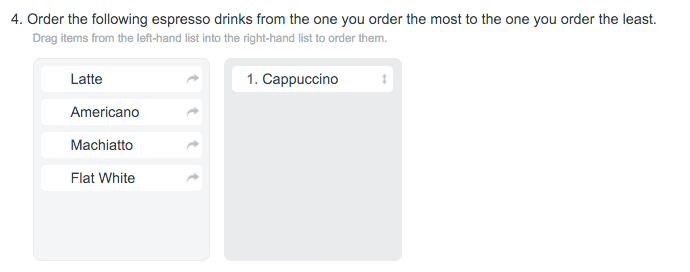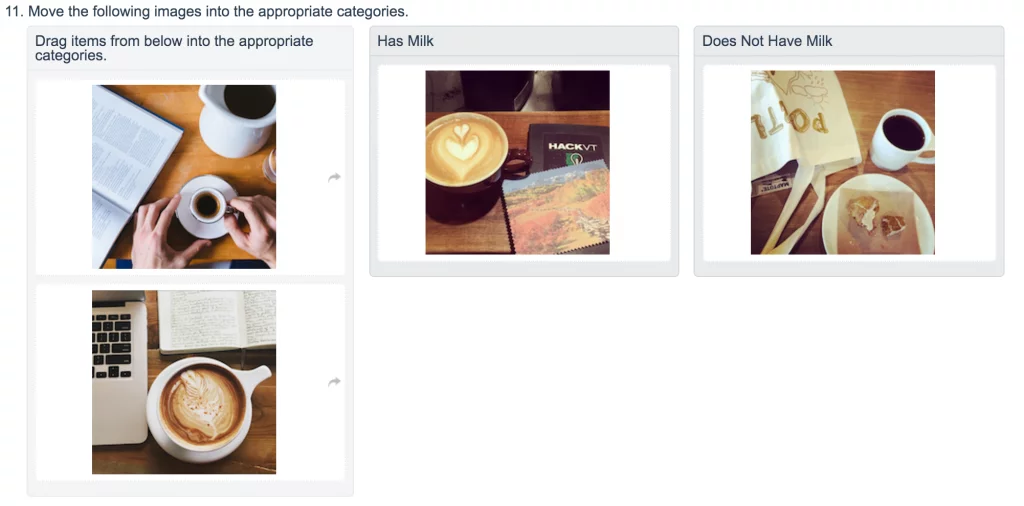Alchemer is an incredibly robust online survey software platform. It’s continually voted one of the best survey tools available on G2, Capterra, and others. To make it even easier, we’ve created a series of blogs to help you better understand what questions to ask, when to ask them, and how to ask them so you get the answers you need.
When designing a survey, one of the first things you need to do is decide the survey’s purpose. Asking yourself, “What is this survey for?” is important, but determining purpose goes beyond this simple question.
While the above question will help you outline what questions to ask and which topics to cover, this is just the beginning.
The crucial follow up question is, “What kind of data do I need?”
This last question is what will determine which question types you will use in your survey. Should you use qualitative questions, quantitative questions, or a mix of both?
First, let’s lock down the definitions of the terms “quantitative” and “qualitative.”
Are Surveys Qualitative or Quantitative?
Surveys can be either quantitative or qualitative, or a combination of both. The type of data you collect depends on the question formats you choose.
- Quantitative: relating to, measuring, or measured by the quantity of something rather than its quality.
- Qualitative: relating to, measuring, or measured by the quality of something (size, appearance, value, etc.) rather than its quantity.
- Quantitative surveys are designed to collect measurable, numerical data. These surveys typically use closed-ended questions, like multiple choice, rating scales, or Yes/No questions. The goal is to gather objective data that can be easily analyzed and compared, such as customer satisfaction scores or purchase frequency.
- Qualitative surveys, on the other hand, focus on open-ended questions that allow respondents to share detailed thoughts and opinions in their own words. These types of surveys aim to gather in-depth insights, often used to understand customer motivations or experiences.
Basically, quantitative data will tell you what your respondents are doing, while qualitative data offers deeper insight into why. In many cases, the most effective surveys blend quantitative and qualitative questions, allowing you to collect both numerical data and deeper, more nuanced feedback. This mixed-method approach gives a well-rounded view of respondents, helping you quantify trends and understand the reasons behind them.
Getting the Facts with Quantitative Questions
Quantitative questions will result in data that is easy to convert into objective, numbers-based analysis.
Quantitative data is easier to measure using statistical analysis, because you can (usually) assign numeric values and directly compare different answers to the same questions.
Examples of quantitative questions include:
- How many times per month do you purchase a coffee from a café or coffee shop?
- How often do you drink coffee at home?
- Do you prefer to prepare coffee at home or purchase from a café or coffee shop?
- If applicable, which café or coffee shop do you go to the most often?
While the word “quantity” has the connotation of being just about numbers, that is not always the case.
In the above examples, the first two questions would be answered with a numerical value. The second two questions, however, would require a written response.
All of the above are quantitative. This is because the answers are objective, telling the basic story of the respondent’s coffee consumption and preferences. These data points are objective.
I like to think of quantitative questions as providing the kind of basic insight that you would find in a survey similar to a census.
As a survey creator asking these kinds of questions, you are really just looking for the basic data points that will enable you to perform a statistical analysis of your respondents.
Quantitative Survey Examples:
There are a wide variety of options for quantitative data questions, which answer your inquiries of “what,” “when,” and “how.”
These include, but are not limited to:
- Radio Buttons: This is the question type to use when you want respondents to select just one option from a list of possible choices. It’s also available in grid format.
- Checkboxes: Similar to Radio Buttons, Checkboxes allow respondents to choose multiple options from a list. This is also available in grid format.
- Drop Down Menus: This is another way to present single-select questions, and it’s available in grid format.
- Drag and Drop: A fun, interactive way for respondents to order or organize responses.
- Likert Scale: This question type is an easy way to get quick insights into where respondents fall on a rating scale for a given topic.
- Slider Scale: This is similar to a Likert Scale, but instead of having a set number of possible responses, respondents can base their input on a sliding scale.
- Star Ranking: This question type will be familiar to anyone who has left a Google review. Using a one-to-five star system (with an option for “not applicable”), respondents rank quality. The grid format is shown below.
- NPS: Usually displayed as a ranking of 1 to 10, NPS scores help you determine how happy a respondent is with a service or product and how likely they are to recommend it to friends.
- Image Select: A fun way to incorporate visuals into your survey, an Image Select question allows respondents to select an answer from a set of pictures.
- Card Sort: A combination of the Drag and Drop and Image Select question types, Card Sort allows respondents to sort cards into categories.
Asking “Why” With Qualitative Questions
In contrast to quantitative questions. qualitative questions, ask “why” in a way that is open-ended, giving respondents the space to provide greater detail about their motivations and reasoning in their own words.
These responses are more difficult to analyze because, for the most part, the answers cannot be quantified using hard numbers. Instead, when analyzing qualitative data, you must be able to think flexibly and creatively to identify important trends and findings.
Examples of qualitative questions include:
- What do you like most about your favorite café or coffee shop?
- How could your favorite café or coffee shop improve?
Why Ask “Why?” with Qualitative Questions
If qualitative questions are so difficult to analyze, then why bother asking them?
Qualitative data gives you insight into why particular trends exist in your quantitative data, and could reveal input that you may not have anticipated.
In the above examples, you could discover that the quality of customer service is more important than the location for café patrons when it comes to determining which coffee shop is their favorite.
Or you might find that while patrons love the quality of the coffee at their favorite shop, they would spend more time there if the shop updated their interiors with more comfortable seating.
When analyzing your qualitative question results, keep in mind your own biases.
Because numbers cannot be easily assigned to qualitative feedback, your own perceptions can make if difficult to interpret the data accurately. That said, sometimes the greatest insights into respondent behavior will be collected via qualitative, not quantitative, means.
Qualitative Survey Examples
Qualitative data questions are a bit more limited, but there is still a lot that can be done with them.
Common qualitative questions include open text questions, like:
- “Other” Box: This is an added option included with a multiple choice radio button or text box questions that give respondents the opportunity to select “Other,” and provide the answer that most applies to them.
- Text Box: A short answer text field where respondents can fill in a few words or sentences about their experience. Text Boxes can also be presented in list form, which is common for contact forms or multiple response questions.
- Essay Box: Similar to a Text Box, but with more room for respondents to include more detail in their answers.
In addition to open text questions, two new question types in Alchemer allow for a mixture of quantitative and qualitative data.
- Heatmap: This question type allows respondents to click on the areas of an image they like or don’t like and provide direct, qualitative feedback on why they reacted as they did.
- Highlighter: Used to solicit feedback on text, the Highlighter question type allows respondents to highlight and comment on sections, providing qualitative feedback on what should be kept or altered within the passage.
When Quantitative Questions and Qualitative Questions Work Together
As you design your survey, consider how you want to use the data you collect. Chances are, you will want a mixture of quantitative and qualitative question types.
Both categories have their strengths: quantitative data gives you the facts, and qualitative data can illuminate the story behind the numbers.
But, both have their weaknesses too.
Quantitative data can be limited in its insight, but qualitative responses are difficult to analyze.
For a successful, actionable, insightful survey, chances are you will need to tap into the power of both quantitative and qualitative question types.

















